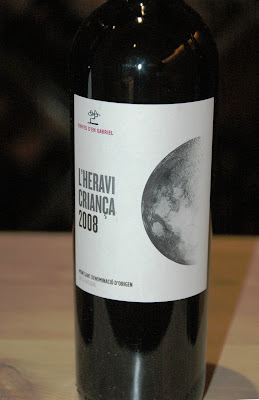Last Saturday, in the highest of spirits, I drove to Poboleda in DO Priorat, to the friendly Mas Sinén winery, to feel what cutting grape feels like.
 |
| The winery ready to receive the grapes. |
Salvador was just leaving the winery to climb the hill with his four-wheel-drive and join the people already working up in the vineyard. When we arrived, they stopped and sat down to breakfast. My timing was perfect!
I was offered a piece of delicious coca de recapte, a precursor, some say, of Neapolitan pizza (in the Middle Ages, Naples and Catalunya were ruled by the same family for some time), and a drink of … not wine, but rather water from the fountain close to the winery.
 |
| Mas Sinén winery from the vineyard. |
Refreshed, we turned to the vines, not before a patient Salvador explained to me the principles of proper grape cutting and selection. It may look easy, but to avoid harvesting gatolls (late-maturing clusters that are still unripe) requires attention. By the way, this is one of the advantages of manual harvesting; machines do not discriminate, but take everything, ripe or otherwise..
At the beginning, all was very well; it was fun, it was relatively early, and friendly clouds obscured the sun.
 |
| Carinyena clusters freshly cut. |
However, after two hours of bending continuously to reach the grapes, my back started to remind me of several things: my overweight, my sedentary habits, and having left behind my 50th birthday. To compound things, the clouds cleared and the sun started to shine down on our backs.
 |
| Tough work ahead (at least for me!) |
One hour later, to my shame, I had to sit down in the shade, utterly exhausted, while my fitter, leaner and younger colleagues clicked on merrily. Fortunately, lunch time was near, and I could make a relatively honourable retreat to the winery.
 |
| The Montsant ridge protects from Northern winds. |
There Salvador was entertaining some visitors, who looked curiously at my rather battered appearance and agreed with me about the high quality of the wine they were sipping: the new Petit Mas Sinén. After they left, Conxita and Salvador prepared lunch: fresh, real tomatoes (nothing to do with the somewhat similar fruits found in the cities’ markets) and lettuce, small Arbequina olives, coca de recapte, Catalan sausage and fried white beans, sweet coca with dark chocolate. Excellent! Some friends of the winery came for coffee, and we sat for some time discussing the harvest and future projects of this dynamic pair.
 |
| Skins float to the surface to form the cap. |
After coffee it was time for work (light this time – or perhaps the lunch had given me extra strength): a small tank of Merlot was fermenting, and the cap, formed by the skins and pips that float to the surface, had to be broken and mixed with the must below. In the process, the gas foams through the must showing off the beautiful pink colour that contrasts with the dark cap.
 |
| After breaking the cap, the gas foams up showing the beautiful colour. |
This process is called pigeage, and is done by mechanical means in bigger tanks, but has to be performed manually five to six times per day in the smaller containers.
 |
| Manual pigeage. |
 |
| Bloodstains? Wrong! Merlot juice! |
Suddenly it was seven in the evening. I had to drag myself to my car and leave Poboleda, thankful to Conxita and Salvador for an amazing, if exhausting, day. I must come back next year, but better trained!









